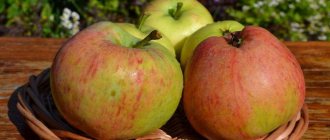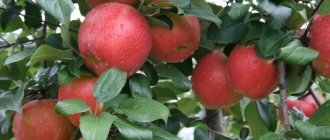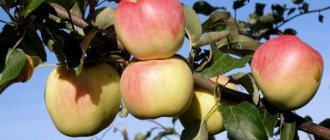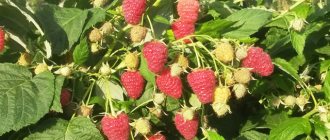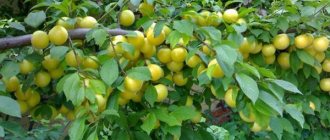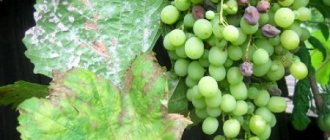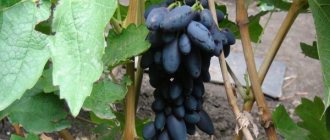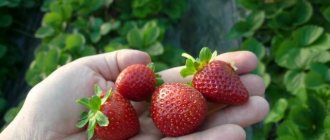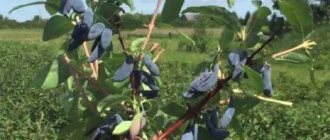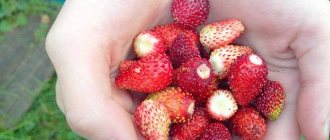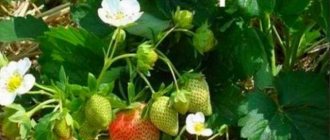Gardening » Apple tree
0
587
Article rating
Kira Stoletova
The Hornist apple tree is a striking example of the symbiosis of fruit crops. Academician Kotov from the Sverdlovsk region received it in several stages. Korichnevka was crossed with Ural apples, and the resulting variety, having undergone free pollination, turned out to be very tasty.
Features of cultivating the Hornist apple tree
Description, photo
Hornist is a summer-ripening variety.
The variety was obtained at the Sverdlovsk Experimental Horticulture Station from open-pollinated seeds of the hybrid form Cinnamon Striped and a mixture of pollen from different varieties of Ural apple trees.
Having passed all the test work, the variety was included in the State Register and in 2002 zoned for the Middle Urals.
Further, having established itself well in this region, the apple tree spread to other regions of Russia.
additional characteristics
Advantages and disadvantages
The benefits of apple trees include:
- High frost resistance;
- Good yield;
- Immunity to scab.
Dimensions of an adult tree
The tree is quite vigorous, 8–9 meters high, and has a wide pyramidal crown. The skeletal branches of a reddish color are raised upward, spreading to the sides with age.
Frequency of fruiting
The tree has a stable, annual harvest throughout its life.
Hornist does not bear fruit periodically.
Productivity
One adult apple tree produces up to 90 kg of ripe fruit . From one hectare the harvest can reach up to 100 centners.
Tasting assessment
The fruits weighing 90 - 120 g have an oblong, ovoid shape. The skin is creamy, with a red base coat, with a dark yellow tint. The pulp is dense, rough, sweet and sour taste, very aromatic and juicy.
Fruits of the Hornist apple tree.
Winter hardiness
The frost resistance of the fruit crop is compared with the Uralets variety . The tree adapts quite well to spring and autumn frosts, and also tolerates low temperatures of 33 degrees.
Disease resistance
Thanks to high immunity, the fruits and foliage of the tree are not damaged by scab even in years with high humidity.
The bugler is not affected by scab even in rainy years.
Important! The apple tree is often attacked by rodents and harmful insects.
Description of the Bayana apple tree variety
Apples: what it looks like
The skin of the fruit is smooth, dense, but dull in appearance; it has neither an oily nor a waxy coating. Its main color is green when unripe, becoming golden yellow as it ripens. On the surface there is a dense integumentary blush of carmine red or purple color, occupying approximately 75-90% of the surface. Subcutaneous dots are grayish-green, very small, sparse, and poorly visible on the surface. The chemical composition is characterized by the following indicators per 100 grams of product:
- P-active substances (catechins) – 234 milligrams.
- Ascorbic acid (vitamin C) – 21 milligrams.
- Total sugars (fructose) – 13.9%.
- Pectins (fiber) – 18%.
- Titratable acids – 0.54%.
The pulp is medium density, fine-grained, very juicy and tender, with a pleasant sweet and sour taste with a bias towards sweetness. It has a well-defined creamy tint. The taste is harmonious, dessert-like, balanced, with a medium-pronounced aroma. According to a professional tasting assessment, apples score 4.6 points for appearance and 4.5 points for taste out of 5 possible.
Apple tree Bayan: characteristics
Crown and root system
It is believed that the Bayan variety is of medium height, since in about the first ten years it can stretch no more than 3-3.5 meters. The maximum tree can grow to about 5 meters, but most gardeners do not allow it to do this. In this case, the crown is most often of medium density, broom-shaped or reverse pyramidal, and can become spreading over the years. The branches extend from the trunk at an acute angle, most of their tips pointing upward. The shoots are covered with bark of a gray-green or steel-gray color, with slight pubescence.
Bayana's leaves are medium-sized, oval, leathery, smooth, glossy, with delicate nerves, slightly elongated, short-pointed tips. They have a green or light green color and pubescence on the back side, with a serrate-crenenate jagged edge. The root system is highly branched, of medium depth, and depending on the rootstock, it may or may not have a central core.
Productivity and pollination
At a young age, for about 10-15 years, the yield of an apple tree remains at an average level, although for a Siberian variety even 75-90 kilograms is quite a significant result.
It is believed that Bayana is self-fertile, therefore it is capable of self-pollination with the help of insects and wind. However, experienced gardeners note that if there are other varieties of apple trees nearby that are suitable for flowering periods, the variety bears fruit much more actively. It is recommended to take out mobile apiaries directly to the plantings during flowering in order to further increase the yield.
Winter hardiness and disease resistance
These apple trees have a high level of resistance to low temperatures. They tolerate even bitter frosts down to -32-37°C with virtually no damage. If they do get some kind of frostbite, they recover very quickly, in just one season, and continue to bear fruit fully. The only thing you have to take care of is drafts; trees don’t like them and can start to hurt.
At the genomic level, Bayana has stable immunity against powdery mildew, as well as scab. That is, they are never affected by such diseases, but this cannot be said about cytosporosis or black cancer. It is advisable to treat apple trees with fungicides and insecticides in a timely manner to avoid problems in the future.
The variety is considered relatively new, therefore it does not yet have subspecies. However, it is grown on dwarfs, semi-dwarfs, and standard clonal rootstocks. In addition, in even more northern regions with harsh and long winters, many choose to grow semi-cultivated Bayana on a seed rootstock. Basically, it grows in the form of a bush, bears fruits weighing no more than 100-120 grams, is compact and can tolerate frosts down to -40-42°C. The only drawback of the variety is cracking of the skin of the fruit in constantly rainy weather or simply excessive humidity, for example, with excessive watering.
Reviews
Pankova. S. Yu. Chuvash Republic. “I thought for a long time about the best variety of apple tree to plant on my plot. After considering all the options, I settled on Gornist, and several years later I have not regretted my choice. The fruit crop is undemanding in the choice of soil. Adapts well to both droughts and prolonged wet weather. My seedling took root without any problems and quickly began to develop and grow. Thus, I collected the first harvest 5 years after planting. The first fruits were medium in size, but very tasty. With each subsequent year, the yield has increased many times, now I collect up to 60 kg of apples from one tree.”
Alexei. Blagoveshchensk. “I have summer and autumn varieties of apple trees growing on my plot. Among the summer varieties, I would like to highlight the Hornist apple tree. In terms of productivity, Hornist is not inferior to other crops, even surpasses them. Over the entire period of time, I have not observed any periodicity or decline in the harvest. Table fruits are of fairly good quality and ripen in mid-August. The only thing is that the apple tree needs constant pruning and fertilizing with fertilizers, which contributes to the quality of its fruits.”
Yusupova. L. Vologda region. “I really love Gornist apples. They have a unique taste and aroma and are dense, hard and coarse-grained in consistency. I buy them from my neighbor's grandmother at the end of summer. I like them not only fresh, but also processed and preserved. I make various preparations for the winter from apples: I freeze and dry them.”
Features of the variety
Trees of the Gornist variety are distinguished by their powerful appearance and good growth. An adult apple tree reaches up to 9 m in height. In the first years, while the crown is just forming and the tree is growing, it has a pyramidal shape, but in an adult plant it already takes on a spherical shape. The main branches, on the ringlets of which the fruits are located, grow straight and are covered with a reddish flaky bark.
Apple Tree Hornist
Apple tree Airlie Geneva
The leaves have the traditional ovate shape, but are very wide. They are painted green and are attached to a short stalk. When flowering, the characteristic apple pink buds first appear, which turn white when blooming. The petals are curved upward, the flower looks like a saucer.
An important feature of this variety, and most likely a disadvantage, is the self-sterility of the plant species. In order to get a harvest every year, it is imperative to plant other varieties nearby.
Interesting fact. Apple trees of any other varieties can be planted as a pollinator, but it should be taken into account that they must have a similar fruiting period.
After grafting, the plant will produce fruits in 4-8 years. From one mature tree you can collect up to approximately 80 kg.
The plant has good frost resistance. In terms of resistance to cold frosty winters, the tree is not inferior even to the famous Uralets variety. The great advantage of this species is its good immunity to scab and other fruit diseases.
Early tasty fruits grow of medium size, the weight of each of them reaches 90-110 g. The shape of the apples is oblong, ovoid, and has slightly pronounced ribs. Their funnel is narrow with a pointed canonical shape.
Apples look like eggs
Apples have a creamy flesh color with a bright red outer cover. The peel is thin and smooth. The fruits of this variety are distinguished by their great juiciness, but at the same time the pulp contains some roughness and coarse grain. The taste rating on the corresponding scale is 4.4 out of 5 possible.
The chemical composition of the fruits of this variety is as follows:
- sugar – 9.3%;
- dry soluble substances – 11.5%;
- acids – 0.7%.
The fruits of the Gornist variety have a relatively low content of ascorbic acid - only 11 mg per 100 g.
Harvesting can be done around the 20th of August. But it’s bad that you won’t be able to store the tasty fruits of this variety for a long time. The maximum storage time for harvested apples is about 20 days. Therefore, after collection, you should quickly eat or process them.
Features of planting and care
Landing
Deadlines
The best time to plant a seedling is considered to be autumn , 3 weeks before the first frost appears.
At this time, the tree has time to take root before the onset of winter, and in early spring it enters a phase of active growth.
Watch a video about autumn planting apple trees:
Distance
at a distance of 5 meters from other crops ; this arrangement contributes to good lighting of the tree and ease of care.
You should know! Apple tree rootstocks for low-growing crops reduce the planting area on the site.
Growing, agricultural technology
The fruit crop is undemanding in care. For better yields, perform the following work:
- Regular watering during the dry season;
- Wood pest control;
- Fertilizing with standard nitrogen and mineral fertilizers.
The apple tree requires regular watering.
Despite the fact that the variety is highly frost-resistant, the apple tree should still be protected from severe frosts in winter. To do this, in late autumn the soil around the trunk is mulched with humus, and the tree itself is covered with burlap.
Watch the video on how to protect apple trees from pests:
And a video about how and what to feed an apple tree:
Pruning and crown formation
Due to the fact that the apple tree has a rather spreading crown, the tree needs regular pruning . In the early stages of development, branches that are weak, crooked and growing at an acute angle to the trunk are removed from the tree.
Apple tree pruning diagram.
Watch a video tutorial on pruning apple trees:
Pollinator varieties
The fruit crop is self-sterile . To set fruit during flowering, cross-pollination with other varieties of apple trees is necessary.
Diseases and pests
One of the distinctive qualities of the Gornist variety is its enormous resistance to scab .
Even in unfavorable years, the leaves and fruits of apple trees remain unharmed.
However, invulnerability to the fungus does not make the tree completely protected from the problems inherent in apple trees - it is susceptible to infection by insect pests. His worst enemies:
- apple sawfly,
- weevil,
- leaf roller,
- flower beetle,
- aphid.
Treatment of the tree with complex insecticides , the use of odorous traps to destroy flying individuals, and trapping belts that prevent the movement of insects along the branches will save you from them.
With proper care, Hornist will provide the gardener with a large and stable harvest of fairly early fruits.
Despite the fact that they do not have a long shelf life, these apples are very good for making juices and compotes, which can be stored for a very long time.
Features of ripening and fruiting
Fruiting
Start
The apple tree is not a fast-growing crop. The first fruiting begins 8 years after planting.
Hornist begins to bear fruit in the 8th year.
Period
The fruit crop has a long productive life span of more than 50 years.
Deadlines
Maturation
Bugler is a summer variety . Ripe fruits are harvested on the twentieth of August.
Storage
After picking, the fruits do not lose their quality for 3–4 weeks , then they begin to deform and become flabby.
Hornist fruits are stored for no more than a month.
How to choose seedlings?
In centers and nurseries that grow fruit crops, apple trees that are one or two years old are sold. Such trees take root without problems. You need to choose a seedling with a smooth trunk and fresh buds without cracks or dents. There should be no stains on the branches either. A healthy and strong apple tree has a root that is at least 40 cm long.
Apple variety Hornist. Photo layout.
High-quality author's original “ Gornist apple variety. Photo " will be presented in the upcoming Atlas of varieties. See photo of the variety .
Description of sections of the page “Gornist apple variety”.
1. Apple variety Hornist. Description. 2. Apple variety Hornist. Advantages and disadvantages. 3. Apple variety Hornist. Photo.
What kind of roses are obtained from seeds from China and how to grow them at home? Risks and features of landing
Apple Tree Hornist
On a dwarf rootstock
The Hornist apple tree on a dwarf rootstock reaches no more than 1.5 - 2 meters in height and has a very spreading, wide horizontal crown of 3 meters. The variety on this rootstock is more frost-resistant and has early fruit ripening. The first fruiting of an apple tree begins 3–4 years after grafting.
The height of the apple tree depends on the rootstock.
The apples are medium in size, and according to the tasting assessment they are not inferior to the regular variety. The fruit crop on a dwarf rootstock is suitable for cultivation in all regions of Russia.
Stambovaya
Hornist apple tree on a standard rootstock is a decorative type of plant. An adult tree reaches an average height of 3 meters and has an unusual dome-shaped crown. This rootstock is valued:
- High productivity;
- Early fruit ripening;
- Frost resistance;
- Scab resistant.
By planting this tree, gardeners not only collect large, tasty fruits, but also decorate their plot with the tree.
Flowering standard apple trees.
Advice! In order for the tree crown to always have a decorative appearance, it must be shaped annually.
Varieties and methods of cultivation
The frost-resistant variety is grown in two ways: on a dwarf rootstock and by standard planting. Hornist is a vigorous tree, reaching a height of 9 meters. Included in the State Register of Varieties of the Ural Region.
On a dwarf rootstock
When growing Hornist on a dwarf rootstock, it is possible to achieve early fruiting of a young seedling, the height of a vigorous tree is reduced, the plant is suitable for mass group plantings, and the harvesting process is simplified.
Stambovaya
A modern, convenient way to grow apple trees. With the help of standard plantings, a decorative and attractive appearance of the orchard is formed.
A spherical crown is formed on the bare trunk of an apple tree without unnecessary branches, and the height of the tree varies from 1 to 2.5 meters.
Growing in regions
In Siberia
The apple tree is unpretentious to the soil and is quite winter-hardy, so with proper care it can grow well in Siberia.
Apple tree care in this region includes:
- Crown formation in slate or tiered form;
- Protection from rodents and insect pests;
- Sheltering a tree before winter;
- Timely application of fertilizer.
By following these simple steps, the apple tree will bear fruit regularly without periodicity or decline in the harvest.
In the Urals
Initially, the variety was bred for the Northern regions of the Urals. After all the test work, it has proven itself very well in this area of Russia.
The only thing worth paying special attention to is that the top layer of soil in the Urals is quite hard. To ensure good saturation of the root system with air, the tree trunk area of the apple tree is regularly loosened and weeded from weeds throughout the entire period.
In the Urals, special attention should be paid to caring for the tree trunk.
